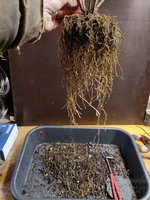leatherback
The Treedeemer
And climateIt depends on the type of akadama...
and type of winter care
My plants stay outside. In rain, all winter. When it gets cold, everything is soaked, freezes for a few hours and gets rained upon again. Do that 15-30 times a winter and the stuff falls apart.
Add to that that fact that it is shipped from halfway around the world
Add to that that I in fact do not believe it has such important magical properties.. After all, it would be a gigantic coincidence that growing bonsai was developed exactly in the only place on earth where the only suitable substrate is mined.
But, the last time someone convinced someone else on internet was 100 years ago. I know what gowth I get. I know the roots I get. AND I know what yellow mud looks like. So take my posts as a word of forewarning. Many use it with great results. Many grow great bonsai without ever using it. Some have had trees dying because of the temporary structures. By all means, try it. Test it. But do it on material that is not near and dear.
And Walter Pall does not use it, nor does Harry Harrington. Not sure what the point is.Sergio (Mach5) uses straight akadama with a splash of kiryu, David Cotizas from Spain uses 70% akadama and 30% kiryu, and Ryan Neil uses straight akadama for everything
In the end, it is nto important. It is important to use a substrate that drains well, aerates well and add fertilizer & water at intervas suitable to the species, care and location. All else is margin-work, in my view.

